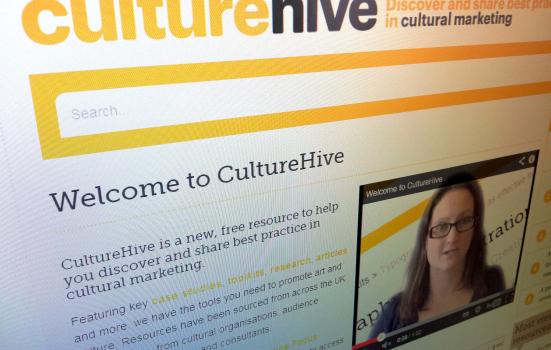How much has the arts marketing role changed in the last twenty years? Strikingly, says Sarah Chambers, who examines what is now required to market culture.

Having worked in marketing communications for over 17 years, I am one of those who remember professional life before digital strategy, segmentation and customer relationship management (CRM) were common currency. With e-communications in its infancy, and a mailing list stored on Excel, the marketer sat on boxes of leaflets and had desks full of faxes, but had a keen eye and a sharp focus on selling. Fast-forward to present day and it is clear that things have changed. But I am struck by the extent to which the role of the marketing professional has developed, changed and spread to cover many new areas of uncharted territory.
That change is a reflection of the healthy, growing ambition of arts organisations in the twenty-first century, and of the economic journey the sector has taken in the last decade. The modern organisation has a much broader, more exciting remit. Global reach, commercial viability, customer-centric thinking and sustainable working are all considerations in the typical arts organisation’s business plan. This means marketing professionals are now working for organisations with trading arms as big as the creative teams. Their digital ambitions are matched only by global touring or broadcast plans, and by creative organisational strategies for growth areas such as CRM, audience development and sustainability.
The marketing professional has become more of a ‘lynchpin’ of organisational development than ever before
These organisational ambitions and strategies are underpinned by a real need to respond to and reflect the changing face of arts funding. Ticket sales and subsidy are no longer the only ingredients that make up the recipe for the arts organisation pie. Ambitious targets and business plans are achieved through a concoction that includes setting targets for increased secondary spend and commercially viable trading arms, maintaining successful relationships with sponsors, funders and donors, and monetising digital content or ‘spinning out’ creative IP – all of this on top of the usual traditional sales revenue.
While pulling together articles and case studies on marketing strategy for Arts Marketing Association’s CultureHive website, I talked to marketing directors and managers from different sectors across the arts. One strong theme emerged: the diverse and at times ‘specialist’ nature of the roles they now inhabit.
I found professionals who talked about leading complex online integration and web launch projects, heading up brand strategy initiatives, writing white papers on CRM or pricing, tackling issues around how to sell more restaurant covers, or sell tickets to an international transfer, or leading on very detailed projects about influencing social change and participatory practice through audience development. Those people were often tackling a number of these projects at the same time; the common theme was that all these projects had marketing at the centre but involved many other departments, functions and internal and external decision-makers.
This throws up an interesting proposition for the marketing professional to consider: that in the necessary move from tactical sales to increasingly more strategic projects, some quite specialist in nature, the marketing professional has become more of a ‘lynchpin’ of organisational development than ever before. And our ‘traditional marketer’ (that keeper of the box office figures) has now morphed into an enabler of the many new or cross-departmental projects, wearing multiple ‘hats’ within the organisation. In this context, is this diverse role called ‘marketing’ heading in a desirable direction, or are marketers becoming jack-of-all-trades, but masters of none?
In tackling what is essential in marketing strategy, and reviewing articles from the sector, it soon became clear to me that articles on ‘how to plan a good straightforward marketing campaign’ would not hit the mark. Many of the potential contributors I spoke to had their strategy deeply rooted, not in SWOT analyses or tactical building blocks, but rather a series of big problem-solving projects, or new initiatives that matched the important strands of their organisation’s work.
For example, in the case of Canterbury Festival and its ‘Prosper Project’ and the Science Museum and its promotion of ‘Science Museum Lates’, the important output for the organisation was initiating new community collaborations and the acquisition of a different kind of audience. It is clear in both case studies that the marketing function was important to broker a meaningful link between the planning process and the potential audience. The style of curation that led to new access to museum collections from late events (Science Museum Lates) or the method of carefully creating community collaborations that can change people’s perspectives (Prosper) can only be done when there is a synergy between audience development aspirations and the creative and artistic planning process. Marketing professionals have to work harder than ever to achieve a mutually beneficial dialogue with creative teams, if these new projects are to get off the ground. And these projects are more diverse than ever, from late-night science clubs for adults, to orchestral collaborations targeting new attendees or digital spaces designed to attract a younger cohort. These projects are growing in ambition, scale and organisational accountability, with audience development central to the definition of success.
Our ‘traditional marketer’ ... has now morphed into an enabler of the many new or cross-departmental projects, wearing multiple ‘hats’ within the organisation
The need for a solid strategy around commercial sales and secondary spend is another area that has grown in importance for marketing professionals. Retail consultant Michael Richards talks about “retail finally having a voice” within cultural organisations. In his article he stresses the importance of the marketing team needing to use all of its tools to promote the retail offer within their organisation, and not separating this function out. Some people felt at times that the specialist nature of establishing ‘destination retail or catering spaces’ was slightly outside their comfort zone, and that more could be done to support those people who have found themselves with this in their portfolio. Others suggested that, as long as you are able to commit to an improved strategy on how you manage customer relationships and improve that visitor experience, it makes sense that the marketing professional is at the heart of ‘all things customer-facing’ from tickets and shops to cafés and DVD sales.
Certainly there is a growing need for marketing to instigate a strategy (if one does not already exist) for tackling how we treat the visitor and how we shape their journey. An article by Heather Walker of the Roundhouse outlines the urgent need for organisations to streamline their front-of-house experience. And while some organisations can enlist a visitor services manager or CRM specialist to do this, many others are using the marketing team to act as a lynchpin between all of the customer-facing functions in order to ensure that the customer gets a consistent view of the organisation. As a result, many marketing managers are tackling the layered topic of creating a CRM strategy and infrastructure that best suits their organisation (see article on CRM I have written for CultureHive).
A number of people also indicated that the biggest ‘spread’ in their remit was the way in which they now needed to be the central figure in some very complicated web projects. Linking third-party suppliers’ technical jargon with creative directors’ digital ambitions can at times lead to months of challenge. In the excellent case study of the Rijksmuseum the director’s ambition to give free digital access to the entire collection drove the project forward, but there was a steep learning curve for the teams involved, especially the communications team, to ensure the project was translated in a way that made sense to the end-user.
Also central to the marketer’s role was the need to understand and service the new ways in which funders now need to be engaged. Newly formed and creative commercial sponsorships, Arts Council England, the Heritage Lottery Fund (or other funding initiatives and programmes) and exciting strategies for deeper engagement with donors and members all rely on the interdependency of the development and marketing functions. Tired old stats and off-the-shelf packages are not what funders and sponsors are looking for. Strong funding relationships rely on exciting new ideas: evaluation techniques that prove you can do what you say you can in your proposal, and, above all, clear business insight and strategic marketing thinking. Marah Winn-Moon demonstrates in her article that there is a huge potential for development and improvement of the role of marketing strategist in these relationships.
So, is there a new version of the old marketing professional now fully embedded in our UK arts organisations? One who flits between chairing complex web meetings to manning sponsors’ breakfasts, writing CRM strategies and commercial trading plans, charting new territory in audience development initiatives or literally planning campaigns in unchartered territories across the globe? And if so, what can be done to support them?
Resources such as CultureHive will help to add that crucial support, with articles and case studies written with good, honest, outcome-based analysis and knowledge sharing at their heart. But the way professionals I spoke to are coping with the demands of an ever-changing, ever-expanding portfolio is by adopting the same old methods that have stood the test of time: using networks and contacts to get the best advise possible, direct from those who have tried it, and entering into every project with a strong sense of motivation and commitment to get the job done. Even when the rules of engagement seem a little alien. Not forgetting, of course, a recognition that the days of saying you only do straightforward tactical marketing and sales are long gone – and the profession is more exciting and rewarding as a result.
Sarah Chambers is Executive Director at Wonderbird.
www.wonderbird.eu
This article has been written as part of CultureHive best practice, a programme managed by the Arts Marketing Association in partnership with The Audience Agency. Developed with Lottery funding from Arts Council England, the website at www.culturehive.co.uk contains more than 800 freely-accessible resources on cultural marketing.




